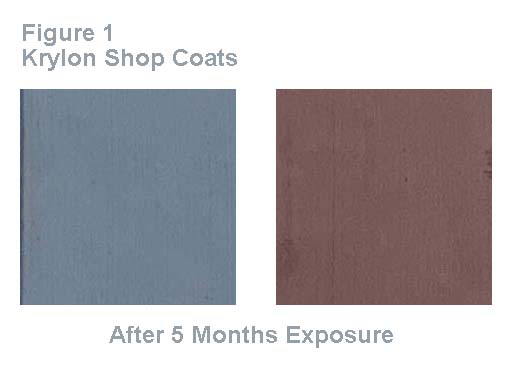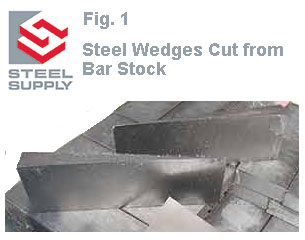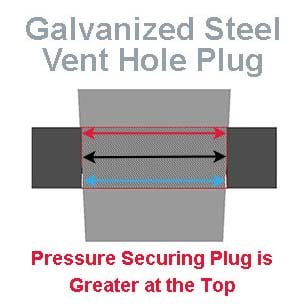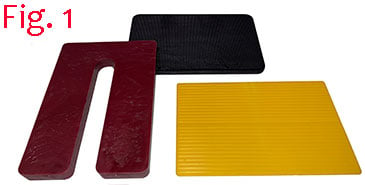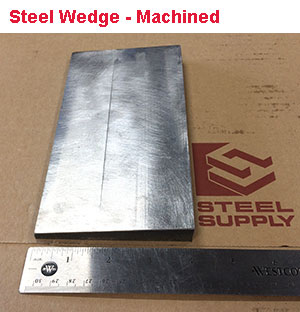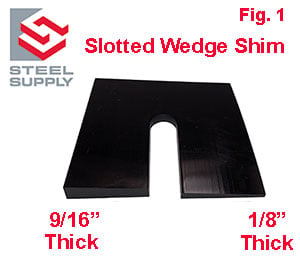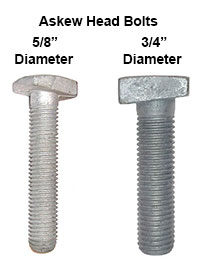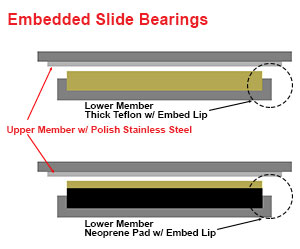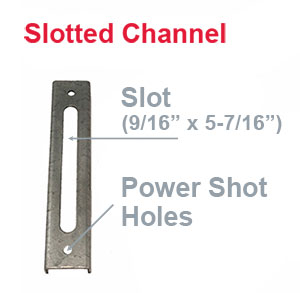Paint and Coatings are a universe of options and complexities. Fortunately for the steel fabricator the scope is limited by the requirements. Priming forms the basis of the coating system and often that is the only coat the steel will receive. Most of our customers prime steel in red or gray. Some of the miscellaneous and ornamental fabricators choose black. A few, for marketing purposes, choose their own color, such as green or blue to stand out on a job-site so anyone seeing the steel knows it was their work. Regardless of the color the basic primer has one function. Prohibit rust until the structure is enclosed.
Steel Manufacturing Blog: Keeping it Steel
When manufacturing made to order steel wedges there are a number of ways it can be done and usually the configuration dictates what method is selected. Some of these are outlined in a previous blog, Steel Wedge Manufacturing. The Steel Wedge we are focusing on in this conversation is required as part of a Fluorogold® or Teflon® Slide Bearing Assembly. Length is 20", Width is 14". Thickness starts at 1/2" and tapers down to 1/16". The unique size of this wedge dictates the manufacturing process.
Tags: Wedges, Steel Wedge, Slide Bearings, Steel Wedges Made To Order
The Steel Supply Company provides shims to a variety of construction trades. Solid or Slotted, Plastic or Steel. It should be noted that by solid we mean non-slotted, or what is sometimes called "Plate Shim." The plastic version of these plate shims is still solid throughout. This is differentiated from some plastic shims on the market that are actually hollow in the core. Shims that are not solid cannot deliver the compressive strength required for most construction projects. The plastic shims shown in Fig. 1 are all solid throughout. Note the slotted plastic shim on the left of the image. It's actual dimensions are 4" x 6" x 1/2" thick, solid throughout, and is compression rated to support 90,000 lbs. before permanent deflection occurs. Based on its surface area, that is approximately 4,500 psi.
Tags: Shims, Plastic Shims, Slotted Shims
The Steel Supply Company manufactures steel wedges both as standard stock sizes and made to order per customer's specifications. A wide range of tools and manufacturing processes are employed and, as with any process like this, costs are kept to the minimum that will allow a high-quality finished part. Nonetheless customers are frequently surprised at the difficulty of wedge manufacturing.
When shims are required to be angled, wedge shaped, or anything other than flat squares and rectangles, specific steps have to be taken to offset the difficulty these angles create.
Tags: Shims, Wedges, Plastic Shims
As described in an earlier blog, 5/8" Diameter Askew Head Bolt published on July 20, 2013, in new construction embedded Wedge Inserts will require 3/4" diameter Askew Head Bolts. The only time a project requires 5/8" diameter Askew Head Bolts is during a renovation where the Wedge Inserts are pre-existing. Usually this would be a structure constructed prior to approximately 1970.
Tags: Askew Head Bolts, Wedge Inserts
We often see RFQ's and Purchase Orders for Teflon® or Fluorogold® Slide Bearing Assemblies where the configuration appears to be carried over from a previous project. Sometimes, without intending to, the plan as shown is overkill for the application at hand. In cases like this we usually give the customer the option of allowing The Steel Supply Company to engage the engineer, architect or designer to introduce alternatives. Below are some examples of common situations. As in all cases, whether they are Slide Bearings, Thermal Break Bearings or any other product line, we will only make suggestions. Changes in design should always be approved by the E.O.R.
Tags: Teflon Slide Bearing, Bearings, Fluorogold Slide Bearing
There are many systems for connecting masonry to steel structures but the two most common the Steel Fabricator will see specified on shop drawings are the Slotted Channel sometimes called a Gripstay, and the Rod Anchor which is also referred to as a Wire Tie. This post will deal with the Slotted Channel / Gripstay Anchor.
The standard single Slotted Channel is 8" long with a slot 9/16" wide by 5-7/16" long. Most commonly it is 12-gauge carbon steel. Finish will vary based on requirement. While it is typically welded to the column or beam, it also
has two holes that allow for power shot nailing in the field. There are versions of the Slotted Channel on the market that will employ 14- or 16-gauge steel. The Steel Supply Company will make these if a project requires it however it does compromise the strength and the interaction with the Slotted Channel Insert is also altered.
Certain projects where the anticipated load may be greater than usual can require the Slotted Channel be manufactured using 3/16" or 1/4" thick steel. If that is the case it is important to verify the inserts will be made with an over sized tab slot.
Steel finish also varies based on requirements. The most common is Mill Galvanized. This thin zinc coating provides a minimum protection from rust, however the areas near the welds will be un-coated. The 8 " Slotted Channel is in stock with a plain or black carbon steel finish, hot dip galvanized or 12-gauge Stainless Steel.
Slotted Channel is also available in an 8' long continuous version, with 12 consecutive slots. The advantage is the Mason will have the maximum number of slots possible to make positive connections. In other situations, the fabricator may elect to use the 8' Continuous Slotted Channel because it does bring efficiency to the fabricating process. They quickly lay out perfectly straight, require fewer total welds, and have the unique break-away sections that allow the fabricator to shorten to the length required without any cutting tools.
8" Continuous Slotted Channel is in stock in both plain 12-gauge carbon steel and 12-gauge stainless steel.
Another variation of the Slotted Channel is the 6" with tabs. As described above this version is useful for power shooting in the field to block or steel. It has the added benefit of being 2" shorter than the standard Slotted Channel allowing it to mount vertically into narrower beam webs. It is important to note the slot is reduced to 3" in length.
For particular and unique applications The Steel Supply Company can manufacture Slotted Channel, Rod Anchors and any other Masonry Anchor to the specific sizes and configurations your project requires.
Tags: Masonry Anchors
The Steel Supply Company has added several new items to the selection of All Threaded Rod. These include;
Tags: Threaded Rod





